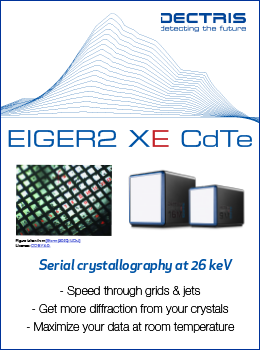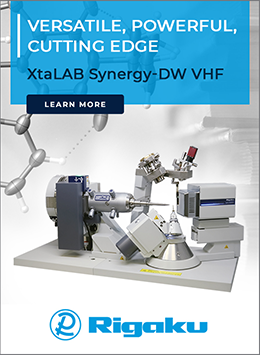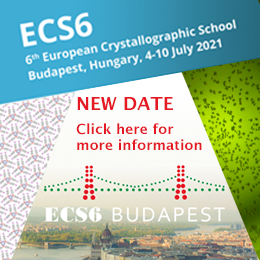


Meeting report
A scientific student conference at Novosibirsk State University: interdisciplinary, international, online
![Thumbnail [Thumbnail]](https://www.iucr.org/__data/assets/image/0009/148635/thumbnail.png)
Science has always surpassed borders, and those imposed by the global COVID-19 lockdown are no different. Around the world, science continues, with conferences and meetings transforming to digital platforms. Inspired by these global actions, a session on "Physical Methods in Solid State Chemistry" of the 58th International Scientific Students Conference (ISSC) was carried out as a live digital conference from 10 to 13 April 2020. This conference was hosted by Novosibirsk State University (NSU), Russia.
Breaking decades of tradition, the NSU Chairs of “Physical Methods in Natural Sciences and Materials Sciences” (Department of Physics) and of “Solid State Chemistry” (Department of Natural Sciences) decided to host a joint symposium at the ISSC. This tradition-breaking decision reflects the early success of our new interdepartmental MSc program "Advanced Techniques in Solid State Sciences", which actively cultivates interdisciplinary discussions between chemists, physicists, geologists and materials scientists. The enthusiastic discussions during the joint ISSC session were a clear testament to the importance and strengths of such a program.
The virtual, interdisciplinary session of the ISSC comprised a total of 33 speakers. This included talks from NSU, Novosibirsk State Technical University, Tomsk State University, Tomsk Polytechnic University, Siberian Federal University (Krasnoyarsk), S. Amanzholov East Kazakhstan State University (Kazakhstan) and even the University of Oxford (UK). NSU was represented by students from across three departments: Physics, Natural Sciences, and Mechanics and Mathematics. Speakers came from a range of levels, starting from first-year BSc students to final-year MSc students. Moreover, NSU MSc students from India and China also participated in the conference. Additional to the impressive list of speakers, conference participants tuned in from across Russia and Europe. Registered participants included those from eight scientific institutes of the Siberian Branch of the Russian Academy of Sciences [1], nanomaterials manufacturer OCSiAl (Novosibirsk), the Kurchatov Institute (Moscow) and members from the ESRF (Grenoble, France).
Demonstrating the strength and reach obtainable through virtual conferences, a quarter of the participants at this ISSC session were not actually present in Novosibirsk during the conference. These participants "attended" the conference without moving from their home city.
The session’s expert panel comprised a highly multidisciplinary team of researchers ranging from mathematicians, physicists and chemists to geologists and mineralogists. This breadth of expertise on the panel was truly necessary, owing to the exceptional level of talks presented by all speakers across a significant range of disciplines. Discussion between participants (speakers, panelists and attendees) was outstanding. Frequently, questions had to be cut short to allow progression of the session. The best speakers were awarded prizes.
Many talks were associated with the use of synchrotron radiation (SR). This included discussion on the development of new elements for the generation of SR, X-ray lenses and new sample holder designs. Presentations regarding new approaches for synchrotron data reduction were also given. Participants heard much about the significant strengths of SR for investigating the structure, properties and synthesis of compounds, minerals, and composite and low-dimensional nanomaterials. In addition, and complimentary to SR, the significant role of other analytical methods in investigating the solid state was made clear. This included discussion of X-ray diffraction and spectroscopy, solid-state NMR, electron microscopy, EELS, electrochemical methods and computational methods (molecular dynamics).
As aptly highlighted by one of the session speakers, physicists actively develop instruments that chemists use, while chemists set the problems for physicists, providing them with objects for studies. This interrelation epitomizes the intertwining nature of the sciences and highlights the importance of interdisciplinary interactions as often and early in scientific careers as possible. One can expand this idea – physicists and mathematicians develop techniques, hardware and software that is further used by, for example, chemists, materials scientists, geologists and biologists. This interaction was very visible during the conference. We plan to use a similar format in addition to the traditional one in the future to increase the geographical spread of participants and nonresident plenary speakers.
![[Fig. 1]](https://www.iucr.org/__data/assets/image/0010/148636/Fig.-1.png)
Feedback from speakers, experts and other participants
Sveta Scharaya (second-year Bachelor student, Department of Natural Sciences, NSU)
I was very happy to participate in this conference as an attendee. Despite the online format, there was a friendly working climate. I liked mostly the talk about the design of novel crown esters.
Maksim Sukhov (fourth-year student, Department of Natural Sciences, NSU, Vorozhtsov Institute of Organic Chemistry; Winner Third Place Oral Presentation Prize)
I was thrilled that, despite all, the conference went ahead in its innovative design. The talks were very interesting, the atmosphere was friendly, everything was well organized. Of course, I am happy to have won a prize recognizing my efforts and commitment to my work!
Amit Kumar Pal (first year, Department of Natural Sciences, Master program “Materials Science”, Lavrentiev Institute of Hydrodynamics)
My participation in ISSC-2020 was a great experience. Using the platform of this conference, I came to know about new scientific research performed by young researchers and scientists. The conference allowed me to interact and discuss my research work with fellow participants. It helped to improve my communication and presentation skills. I appreciate the valuable comments from colleagues and experts and will use their insights to direct my future research work.
Maria Atamanova [second-year Master student, Institute of Engineering Physics and Radioelectronics, Siberian Federal University (Krasnoyarsk); Winner Second Place Oral Presentation Prize]
I would like to thank the organizing committee for the conference. The level of organization pleasantly surprised me. I was anxious about some technical points during discussions because of the online format, but everything was great! The explanations provided about the online format and connection were easy to understand. As a speaker, I just had to worry about my talk, not about technical questions. I have only positive feelings about the conference. I was very happy to attend it and hope to meet everybody in the future, in person.
Andrey Trebushinin (first year of Master program “Physical methods for the condensed state studies”, Physics Department, NSU, Budker Institute of Nuclear Physics; Winner Second Place Oral Presentation Prize)
I am working on optimizing the parameters of X-ray optics for a new SR facility “SKIF”, which is being constructed in Novosibirsk. I worried about the topic of my talk. I was not sure if I could explain my work to chemists, geologists and materials scientists. Other students presented the results of the synthesis of new nanomaterials and of structural studies by X-ray diffraction and spectroscopy. Everything presented by these speakers differed from my own presentation: topics, approaches and even terminology. But then I recognized that these researchers are my future colleagues at SKIF. I am developing the very machine that they will use, and therefore recognized the importance of making my talk understandable for a wider audience. I was amazed by the relevance of the questions I was asked after my talk and the high professional level of discussion. These discussions were very valuable for my work, both with respect to our designing of the efficiency of SR generation and to the optimization of the conditions available for future researchers. I thank the organizers, speakers and the audience for such a pleasant scientific discussion. I am looking forward to meeting everyone again next year, in a face-to-face format!
Nikolay Kahidze (first year of Master program, Physical-technical Department of Tomsk State University; Winner Third Place Oral Presentation Prize)
I am very glad that the conference went ahead and was carried out very successfully. I would like to emphasize the high level of the presentations as well as the expertise of the organizers and coordinators. I also got useful experience in online presentations and learnt how to use Zoom. I think next time it would be great to motivate participants to switch on their web-camera. Many thanks again!
Elena Boldyreva (professor of the Chair of Solid State Chemistry, Department of Natural Sciences of NSU, Boreskov Institute of Catalysis; co-chair of the conference)
I was very happy to see my long-term dream come true – we could organize this student conference not as a local event of the single chair like a defense repetition, but as a true scientific meeting in which experts from various fields come together and discuss the latest scientific achievements. It was pleasant to see that our efforts to harmonize education combining the three main modules (”Solid-state structure and properties – Solid-state transformations and practical implementation – Physical methods in solid-state research”) have started to yield fruit. Many students have already worked at SR facilities either in Russia (Budker Institute of Nuclear Physics, Novosibirsk; Kurchatov Institute, Moscow) or abroad (ESRF, BESSY, Petra, DESY), and also at the European XFEL.
Sergey Tsybulya (professor, Head of the Chair of Physical Methods of Investigation of Solid State, Physics Department, NSU, Boreskov Institute of Catalysis; co-chair of the conference)
Chemistry, mineralogy and materials sciences suggest problems for physicists to solve. The solution of these problems requires the development of new experimental and mathematical instruments. Students should see the possibility of applying their skills and knowledge in other research fields from the very beginning of their education. This should motivate them in their studies. This is extremely important. The joint session has shown that this is today a reality. Not only students but also the expert panel members learnt much that is new from the interdisciplinary research projects presented and discussed at the session. We all were equal participants in the event.
Vladislav Komarov (senior lecturer of the Chair of Inorganic Chemistry, Department of Natural Sciences, NSU, Nikolaev Institute of Inorganic Chemistry)
Organizing the student conference in the online format was a challenging and very successful experience. The strong student talks and the multifaceted questions from the expert panel and audience made this conference a great success, in line with the best professional scientific conferences. I only missed live conversations during discussion breaks … but I hope in the future, technologies will enable them!
Boris Zakharov (associate professor of the Сhair of Solid-State Chemistry, Department of Natural Sciences, NSU, Boreskov Institute of Catalysis)
In my opinion, the united session was a very successful experience. It showed what true interdisciplinary studies are and how science done by mathematicians, physicists and chemists is interrelated. Scientists have a common goal – getting knowledge about the universe. I was pleasantly surprised by the very high level of the contributions; sometimes I had the feeling that I was attending a “real, professional” high-level international scientific conference. The fact that I took part in such an event even during the lockdown regime was certainly a pleasant bonus.
Anna Gaydamaka (assistant to the Solid-State Chemistry Chair of the Department of Natural Sciences, NSU, Boreskov Institute of Catalysis)
This year I attended the ISSC for the first time not as a speaker, but as an attendee. I enjoyed the idea of the joint sessions because it is a chance to become familiar with the work of students from other chairs, departments and even cities. Usually, we are limited by our chairs and narrow topics. Interdisciplinarity is a modern world trend; it is often impossible to divide studies into “physical” and “chemical”. I was impressed by the talks of the students who develop new instruments and software. Some of the students, aged 22–23 years, already have significant experience in taking part in “Mega-science” projects. They work together with experienced senior researchers. Interestingly, the students are not scared to choose difficult problems and new methods. For example, some go into protein crystallography. The well-known paradigm of solid-state chemistry "Composition – Structure – Processing – Performance" can be complemented by another one from physics, "Phenomenon – Method –Instrument", in order to define the novel interdisciplinary scientific approach.
Ella Moroz (leading researcher, Boreskov Institute of Catalysis)
This event is very important, especially nowadays when we have to limit our face-to-face communications. I am grateful to the co-chairs, S. Tsybulya and E. Boldyreva, who did their best to organize this conference. The rich scientific program allowed me to become familiar with the studies of our young colleagues in our country and abroad. I learnt how they master novel instrumental methods and how they are developing them. I learnt a considerable amount about new scientific developments. I liked the friendly spirit, the interest of all the audience; everybody had the opportunity to ask questions. But most of all, I enjoyed the “children”. The speakers answered the questions of the expert panel members and other participants with much confidence. One could see the positive influence of their supervisors. The most important thing – everybody was enthusiastic about their studies. It’s great! It is most important for their future scientific career. In February, I took part in the Winter School of the NSU “Meeting the Big challenges”, which was organized jointly by the Chairs of Solid State Chemistry and of Physical Methods of Studying the Solid State. I was jealous of the “scholars”. Great lectures from leading experts from Russia and Europe, good conditions, food, and social and cultural program. I understood that our science has a future!
[1] Nikolaev Institute of Inorganic Chemistry, Boreskov Institute of Catalysis, Budker Institute of Nuclear Physics, Lavrentiev Institute of Hydrodynamics, Sobolev Institute of Geology and Mineralogy, Vorozhtsov Institute of Organic Chemistry, Institute of Solid State Chemistry and Mechanochemistry, Voevodsky Institute of Kinetics and Combustion.
Copyright © - All Rights Reserved - International Union of Crystallography








